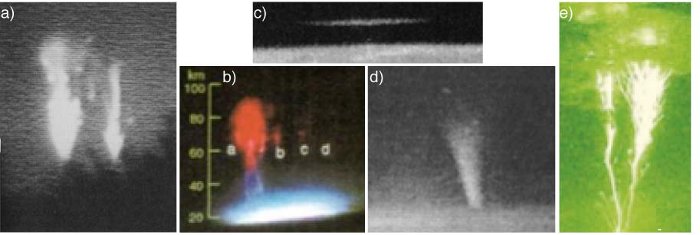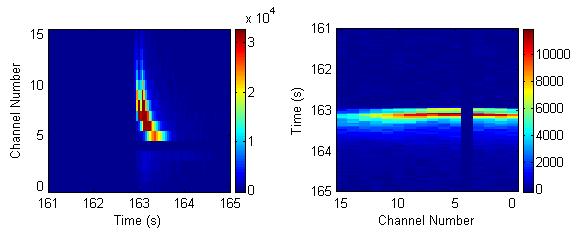Introduction
Until recently, it was thought that the dazzling display of light
offered by a thunderstorm was confined to the lightning activity in the
thunderstorm clouds and between the clouds and the ground.
Introduction
Until recently, it was thought that the dazzling display of light
offered by a thunderstorm was confined to the lightning activity in the
thunderstorm clouds and between the clouds and the ground. This changed in
1989 with the first scientific documentation of a brilliant optical flash well
above a thunderstorm [Franz et al., 1990], following years of intermittent
but persistent verbal reports of such high-altitude flashes by pilots and
others [Vaughan and Vonnegut, 1989, and references therein]. Publication
of the photograph of the flash stoked a great amount of scientific interest in
the subject of lightning-associated high-altitude (above cloud) flashes, and
within a few years a menagerie of different kinds of flashes had been
discovered. The different kinds of flashes were given fanciful names like
“sprites” and “elves” to reflect their fleeting and hard-to-catch nature (and
to steer clear of names suggesting causative mechanisms which had not yet been
pinned down), and the entire category of flashes came to be known as transient
luminous events (TLEs). Examples of various kinds of TLEs are shown in Figure
1.
 |
- Sprites are large, brief, and often highly-structured bursts of
light occurring high above thunderstorms in response to cloud-to-ground
lightning flashes that remove large amounts of charge from the upper portions
of a cloud. A single sprite can span altitudes from 40 km up to 80 km (the
cloud itself is no higher than 15 km) with a width of several tens of
kilometers at its widest. Often, the highest parts of a sprite feature a
diffuse, red glow (called a halo) while the lower parts of a sprite feature
highly structured streamers of a blue color, although halos can appear without
streamers and streamers can appear without halos. Sprites last for several
milliseconds to several tens of milliseconds, long enough to be barely
perceptible to the human eye. The now-accepted theory of sprite formation was
first put forth by the VLF Group
[Pasko et al., 1996; Pasko et al., 1997; Pasko et al., 1995].
- Elves are rapidly expanding rings of predominantly red light
centered well above a causative cloud-to-ground lightning return stroke. Elves
expand radially outward along the lower edge of the ionosphere (80-90 km) with
an apparent speed faster than light and can attain diameters up to 300 km
across (covering an area similar to the size of West Virginia) on timescales
faster than 1 ms. The rapid timescales make elves too quick to see with the
naked eye and difficult to catch on standard 30 fps video cameras, but use of
specially-designed photometric imaging instruments have shown that elves are
easily the most frequently occurring TLE on the planet (a recent 3-year
satellite study observed around 600 sprites and over 5000 elves, with a
globally averaged elve occurrence rate of over 3 elves/min)
[Chen et al., 2008]. Large storms can produce hundreds of elves over the
course of a few hours [Newsome and Inan, 2010]. Elves are an example of a
natural phenomenon that was predicted to occur before it was actually first
observed: the VLF Group first hypothesized the existence of elves in
[Inan et al., 1991].
- Jets are associated with upward-directed lightning shooting out of
cloud tops and vary greatly in size. Blue in color, the smallest jets are
called blue starters and extend only a few kilometers from the cloud top into
the clear air above. Jets extend much further into the stratosphere, to
altitudes around 40 km. Both starters and jets occur relatively frequently
(around the same rate as sprites). Gigantic jets, which reach altitudes as
high as 80 km, are on the other hand exceedingly rare. In the same 3-year
study cited above where over 5000 elves and around 600 sprites were observed,
only 13 gigantic jets were observed, predominantly over oceans
[Chen et al., 2008].
The VLF Group and TLEs
The VLF Group has been deeply involved in TLE research since the subject’s
scientific inception in 1989, making numerous theoretical contributions and
observational discoveries. Much of the VLF Group’s work has been driven by
in-the-field TLE observation campaigns carried out all over the world with
novel imaging instrumentation developed and built at Stanford. Locations for
these campaigns over the years have included the Rocky Mountain Front Range of
Colorado (looking into the US Great Plains), the Magdalena Mountains of New
Mexico, Arecibo Observatory in Puerto Rico, Pic du Midi in the French Pyrenees,
Japan, and South Africa.
 |
Novel approaches to TLE imaging and imaging instruments developed by the VLF
Group include:
- The PIPER Instrument [Marshall et al., 2008], a 64-anode
two-dimensional photometric array imager capable of free-running
(non-triggered) ground-based recording of aggregate elve activity over active
thunderstorms [Newsome and Inan, 2010]. PIPER was the first instrument to
document hundreds of elves from a single storm system as well as observe an
unusual class of elve (elve doublets, see Figure 3) in large
numbers. PIPER has been deployed for TLE observation in New Mexico, Colorado,
Puerto Rico, and France.
- High Speed Video with >1000 fps frame rates (sub-millisecond time
resolution) have been used to study streamer propagation in sprites from
Langmuir Laboratory in New Mexico
[Marshall and Inan, 2005; Marshall and Inan, 2006].
- Telescopic Imaging involving a 41 cm aperture f/4.5 Dobsonian
telescope operated from Langmuir Laboratory made the first discovery of small
bead-like streamer propagation in the highly-structured lower portion of
sprites [Gerken et al., 2000; Gerken and Inan, 2003; Gerken and Inan, 2002].
- The WASP (Wide-angle Array for Sprite Photometry), a two-row
horizontal photometer array, used in numerous sprite observation campaigns,
including the conjugate sprite observation campaign from South Africa
[Marshall et al., 2005].
- The Fly’s Eye, one of the first photometer arrays developed and
deployed to study elves, made significant discoveries about elves’ shapes and
motions [Inan et al., 1997] production by negative cloud-to-ground-flashes
[Barrington-Leigh and
Inan, 1999] as well as the discovery of halos as TLEs
distinct from sprites [Barrington-Leigh et al., 2001].
 |
Acknowledgements
Recent study of TLEs by the VLF Group has been funded by the Office of Naval
Research (ONR).
Portions of this material are based upon work supported by the National Science Foundation under Grant No. ATM-0836326.
Any opinions, findings, and conclusions or recommendations expressed in this material are those of the author(s) and do not necessarily reflect the views of the National Science Foundation.
Bibliography
Barrington-Leigh, C. P., and U. S. Inan, Elves triggered by positive and
negative lightning discharges, Geophys. Res. Lett., 26(6),
683-686, 1999.
Barrington-Leigh, C. P., U. S. Inan, and M. Stanley, Identification of sprites
and elves with intensified video and broadband array photometry, J.
Geophys. Res., 106(A2), 1741-1750, 2001.
Boeck, W. L., O. H. Vaughan, R. Blakeslee, B. Vonnegut, and M. Brook, Lightning
induced brightening in the airglow layer, Geophys. Res. Lett.,
19(2), 99-102, 1992.
Chen, A. B., et al., Global distributions and occurrence rates of transient
luminous events, J. Geophys. Res., 113, A08306,
doi:
rm10.1029/2008JA013101, 2008.
Franz, R. C., R. J. Nemzek, and J. R. Winckler, Television image of a large
upward electric discharge above a thunderstorm, Science,
249(4964), 48-51, 1990.
Gerken, E. A., and U. S. Inan, A survey of streamer and diffuse glow dynamics
observed in sprites using telescopic imagery, J. Geophys. Res.,
107(A11), doi:
rm10.1029/2002JA009248, 2002.
Gerken, E. A., and U. S. Inan, Observations of decameter-scale morphologies in
sprites, J. Atmos. Sol.-Terr. Phys., 65(5), 567-572,
doi:
rm10.1016/S1364-6826(02)00333-4, 2003.
Gerken, E. A., U. S. Inan, and C. P. Barrington-Leigh, Telescopic imaging of
sprites, Geophys. Res. Lett., 27(17), 2637-2640, 2000.
Inan, U. S., T. F. Bell, and J. V. Rodriguez, Heating and ionization of the
lower ionosphere by lightning, Geophys. Res. Lett., 18(4),
705-708, 1991.
Inan, U. S., C. Barrington-Leigh, S. Hansen, V. S. Glukhov, T. F. Bell, and
R. Rairden, Rapid lateral expansion of optical luminosity in
lightning-induced ionospheric flashes referred to as ‘elves’,
Geophys. Res. Lett., 24(5), 583-586, 1997.
Marshall, R., R. Newsome, and U. Inan, Fast photometric imaging using
orthogonal linear arrays, IEEE Trans. Geosci. Remote Sens.,
46(11), 3885-3893, doi:
rm10.1109/TGRS.2008.2000824, 2008.
Marshall, R. A., and U. S. Inan, High-speed telescopic imaging of sprites,
Geophys. Res. Lett., 32, L05804,
doi:
rm10.1029/2004GL021988, 2005.
Marshall, R. A., and U. S. Inan, High-speed measurements of small-scale
features in sprites: Sizes and lifetimes, Radio Sci., 41,
RS6S43, doi:
rm10.1029/2005RS003353, 2006.
Marshall, R. A., U. S. Inan, T. Neubert, A. Hughes, G. Satori, J. Bor,
A. Collier, and T. H. Allin, Optical observations geomagnetically conjugate
to sprite-producing lightning discharges, Ann. Geophys.,
23, 2231-2237, doi:
rm10.5194/angeo-23-2231-2005, 2005.
Newsome, R. T., and U. S. Inan, Free-running ground-based photometric array
imaging of transient luminous events, J. Geophys. Res., A00E41,
doi:
rm10.1029/2009JA014834, 2010.
Pasko, V. P., U. S. Inan, Y. N. Taranenko, and T. F. Bell, Heating, ionization
and upward discharges in the mesosphere due to intense quasi-electrostatic
thundercloud fields, Geophys. Res. Lett., 22(4), 365-368,
1995.
Pasko, V. P., U. S. Inan, and T. F. Bell, Blue jets produced by
quasi-electrostatic pre-discharge thundercloud fields, Geophys. Res.
Lett., 23(3), 301-304, 1996.
Pasko, V. P., U. S. Inan, T. F. Bell, and Y. N. Taranenko, Sprites produced by
quasi-electrostatic heating and ionization in the lower ionosphere,
J. Geophys. Res., 102(A3), 4529-4561, 1997.
Pasko, V. P., M. A. Stanley, J. D. Mathews, U. S. Inan, and T. G. Wood,
Electrical discharge from a thundercloud top to the lower ionosphere,
Nature, 416, 152-154, 2002.
Sentman, D. D., E. M. Wescott, D. L. Osborne, D. L. Hampton, and M. J. Heavner,
Preliminary results from the sprites94 aircraft campaign: 1. red sprites,
Geophys. Res. Lett., 22(10), 1205-1208, 1995.
Vaughan, O. H., and B. Vonnegut, Recent observations of lightning discharges
from the top of a thundercloud into the clear air above, J. Geophys.
Res., 94(D11), 13,179-12,182, 1989.
Wescott, E. M., D. Sentman, D. Osborne, D. Hampton, and M. Heavner, Preliminary
results from the sprites94 aircraft campaign: 2. blue jets, Geophys.
Res. Lett., 22(10), 1209-1212, 1995.